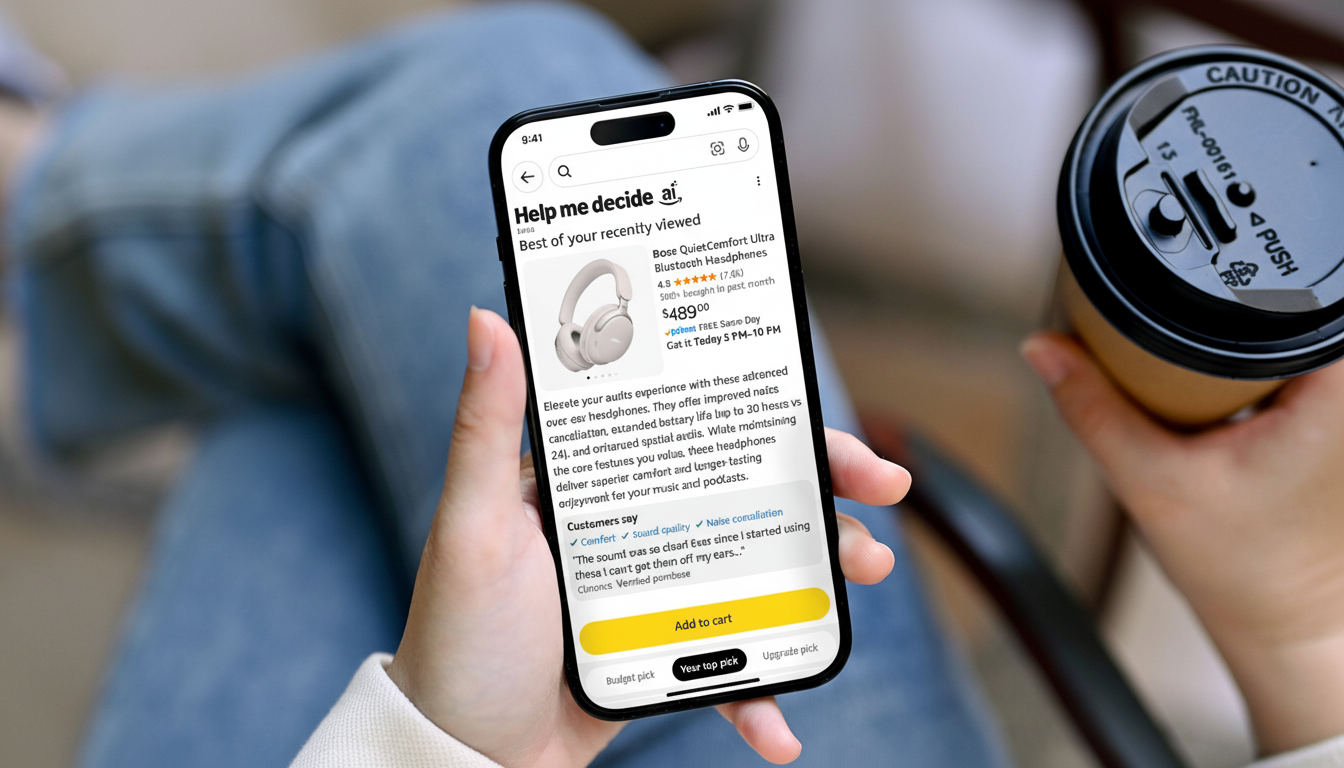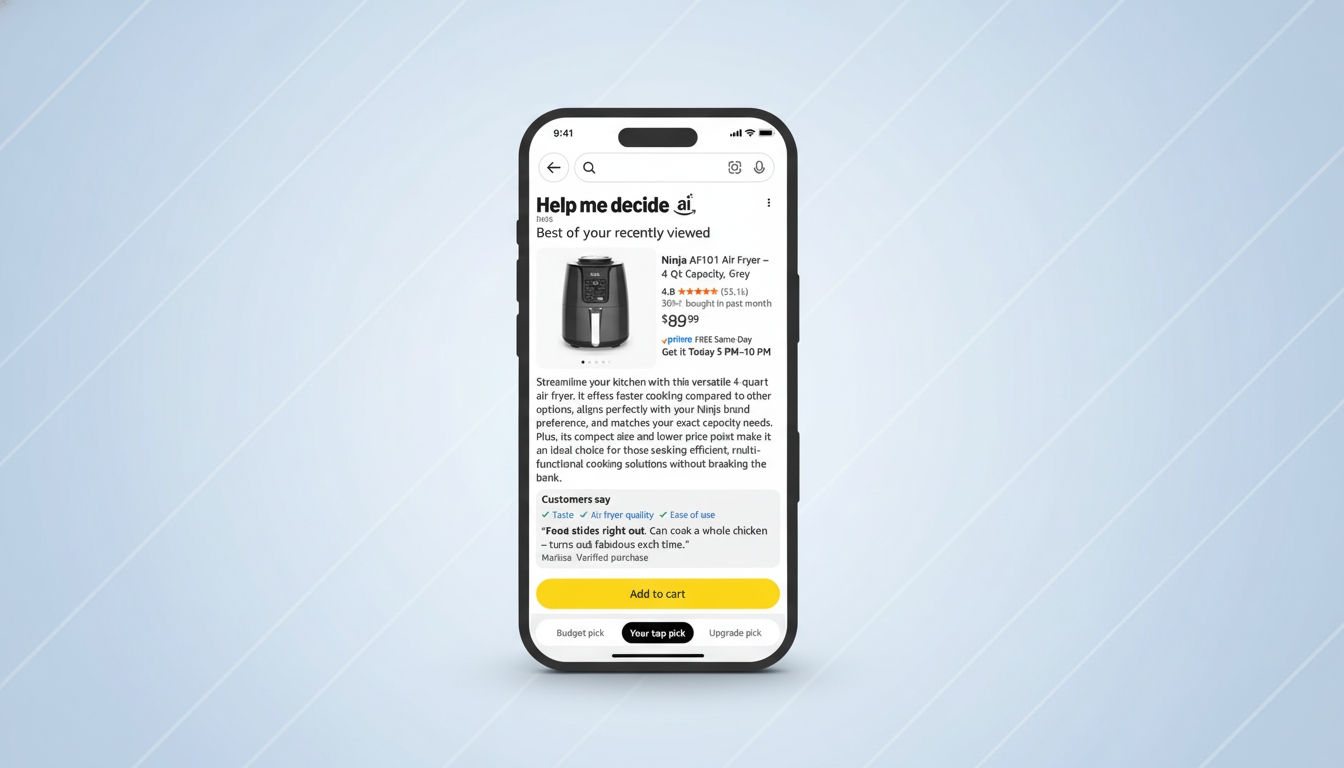Amazon is rolling out a new AI-powered feature called Help Me Decide, designed to cut through comparison fatigue and guide shoppers to a single, well-reasoned pick. Instead of sifting through pages of similar products and conflicting reviews, users get a tailored recommendation grounded in personal buying behavior and product data.
The tool uses large language models and AWS technologies, including Amazon Bedrock, Amazon OpenSearch, and Amazon SageMaker to analyze product specs, review content, and your own shopping patterns. The result is a concise suggestion, delivered with a clear explanation of why it fits your needs.

What Help Me Decide Actually Does for Shoppers
Help Me Decide looks at what you have viewed and bought, what you tend to prioritize, and how similar customers reacted to the same items. It then weighs features, sentiment in reviews, and price brackets to pick a front-runner product and present it alongside an optional upgrade and budget alternative.
Say you have been browsing tents, plus cold-weather sleeping bags for adults and kids, and a car-camping stove. The system interprets those signals as a family trip with low temperatures in mind and may highlight a four-person tent with solid weatherproofing and easy setup, followed by a premium model and a lower-cost pick.
Where It Appears and How to Use It Effectively
On the Amazon Shopping app or mobile browser, the Help Me Decide button typically appears after you have viewed several similar items in a category. You can also find it by tapping the Keep shopping for module at the top of the homepage, which surfaces active browsing themes.
Tap the button to see one recommended item with a short rationale. If you want to compare, toggle to see the suggested upgrade or budget choice. You can refine the context by continuing to browse, which gives the system more signals to work with.
How the Recommendations Are Explained to You
Each pick includes a brief “why we chose this” summary that connects your behavior to the product’s strengths—think “matches your interest in low-light cameras and long battery life” for a smartphone, or “frequently praised for quiet operation” for an air purifier. That transparency helps you understand trade-offs rather than just accepting a black-box answer.
Behind the scenes, OpenSearch helps parse and rank review themes, while LLMs summarize key attributes and reconcile conflicting feedback. SageMaker supports model training and iteration, so the system stays current with new listings and changing preferences.

How It Fits With Amazon’s Other AI Shopping Tools
Help Me Decide joins a growing lineup of AI shopping aids. Interests scans for products that match prompts you set and alerts you when new items drop. Shopping Guides distill complex categories into digestible, expert-like walk-throughs. Rufus, Amazon’s conversational assistant, answers product questions in real time and can reference your past orders.
Together, these tools aim to compress research time and increase buyer confidence. Industry studies back the strategy: McKinsey has reported that effective personalization can lift revenues by 5–15% and improve marketing efficiency by 10–30%, while the Baymard Institute estimates average cart abandonment around 70%—often driven by friction and indecision.
Privacy and Transparency Questions for Shoppers
Because the feature relies on shopping history and browsing signals, some users will want clarity about data use and control. You can manage or clear your browsing history and review advertising and personalization settings in your account to tune how much context the system can leverage.
Amazon has not specified how it prioritizes items within recommendations or whether sponsored placements could influence results. Transparency on ranking criteria and any paid relationships will be critical to maintaining trust as the feature scales.
Why It Matters for Shoppers and Sellers Today
For shoppers, Help Me Decide promises fewer tabs and more confidence, especially in crowded categories where specs blur together. The explanation cards reduce the risk of buyer’s remorse by making trade-offs explicit—battery life versus weight, noise versus airflow, durability versus price.
For brands and marketplace sellers, the feature raises the bar on product detail quality and review health. Clear specs, consistent naming, and authentic reviews are more likely to be recognized and surfaced by AI summarization. Expect increased pressure to maintain accurate attributes and address negative feedback quickly.
Bottom line: if decision paralysis has been slowing your checkout, Help Me Decide is Amazon’s bid to be your tie-breaker—one informed, transparent recommendation at a time, with room to trade up or save without starting over.

